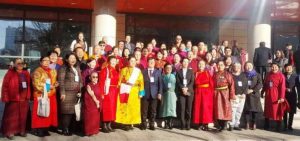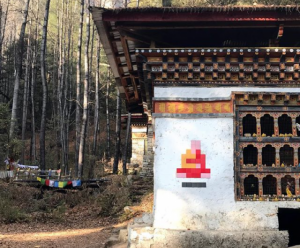The history of the Kandy Dalada Perahera, or “Tooth Relic Procession,” in Sri Lanka is an illustrious one that is closely associated with a holy tooth relic of the Buddha. Fearing unfriendly repercussions from neighboring kingdoms due to his conversion to Buddhism from Hinduism, the king of Kalinga, Guhaseeva, decided to send the tooth relic in his possession from India to Ceylon. Charged with the safe transport of the precious object, his daughter Hemamala and her husband Dantha disguised themselves as Brahmins and arrived at Lankapatuna (now Ilankeiturei) in 310. The Ceylonese king, Kirthi Sri Meghawanna (r. 302–30), welcomed them and with great enthusiasm, installed the relic in the Mahavihara temple in Anuradhapura. These facts are mentioned in the ancient texts Dhatawansaya (Chronicles of the tooth relic), Daladasiritha (Customs and history of the tooth relic), and Daladapujawaliya (Records of offerings made to the tooth relic).
The relic was given a place of great prominence during the Anuradhapura period (377 BCE–1017 CE). The Buddhists (during this period, Hindu merchants and mercenaries also visited Sri Lanka) ardently believed that the tooth relic’s blessing could invoke the rains during the worst periods of drought. Since ancient Ceylon was mainly an agrarian society, the rains’ timely arrival was imperative. Hence, during dry spells, the kings permitted the relic to be ceremoniously paraded through the city streets on the back of their royal elephant, accompanied by drummers and dancers. The Chinese Buddhist monk Faxian (337–422), who traveled to India and Sri Lanka between 399 and 414, stated in his The Travels of Fa-hsien: “The sacred Tooth is then brought out and passes along the central street, receiving the homage of offerings as it goes by” (Giles [1923] 2012, 73). Faxian’s written record is considered to be the earliest known evidence of the Dalada Perahera in the Anuradhapura period.
In ancient Ceylon, the tooth relic was considered a protector of the nation as well as a symbol of monarchy—it was unanimously acknowledged by all Ceylonese that the one who possessed the relic had the right to the throne. Due to its religious and political importance, as the kingdoms in Ceylon shifted, the relic was moved accordingly. The final kingdom of Ceylon was the Kingdom of Kandy (1469–1815). Records from the era indicate that, under the threat of Portuguese and Dutch invaders, Buddhist monks and other dignitaries periodically moved the tooth relic to inconspicuous locations on the island. Joseph Gerson Da Cunha (1842–1900), a doctor and numismatist as well as a man of letters, records that in 1560 D. Constantino Da Bragança, the Portuguese viceroy of Goa, ordered the relic to be “crushed to pieces, cast into a brazier, and the ashes thrown into a running stream” (Da Cunha 1875, 40)—a telltale sign of the relic’s importance as a symbol of monarchy in the eyes of the invaders. In 1658, the Dutch colonial forces eventually defeated the Portuguese and took control of Ceylon. The ensuing British offensive had, by 1796, occupied the coastal areas, resulting in the eventual downfall of the Kandyan kingdom when the British arrested the final king, Sri Wikrama Rajasinghe (1798–1815). However it is noteworthy that, upon their discovery of the hidden tooth relic, the British ceremoniously welcomed it back to Kandy, accompanied by a colorful street procession. This well-planned act demonstrating possession of the tooth relic by the new colonial rulers strongly implied their right to rule over the Ceylonese.
In 1828, when Ceylon was experiencing a calamitous drought, the Sinhalese Buddhist leaders informed the British governor of the necessity to invoke the rains by holding a Dalada Perahera. Agreeing to their request, on 29 May Governor Sir Edward Barnes permitted a procession of the tooth relic in the streets of Kandy. The Perahera of 1828 signified the revival of the tradition lost since 1505 with the arrival of the Portuguese, to be followed later by the Dutch and British. In 1853, the British government permanently transferred custody of the relic back to the Mahavihara temple, also known as the “temple of the tooth.” The Kandy street procession of the tooth relic has since become an annual event.
The Dalada Perahera celebrates the dances, music, religions, and cultural practices of all Sri Lankans. For example, the inclusion of Kawadi dancing teams from the god Kataragama’s temple shows the strong relationship shared by Hinduism and Buddhism in Sri Lanka. Teams of dancers and drummers from the three remaining temples ascribed to the gods Natha, Vishnu, and Pattini take part in the procession as well. However, more prominence is given to the Perahera of the “temple of the tooth” and the relic itself.
Over the years, the Perahera has been transformed according to the needs of the time. It is currently controlled by the traditions of Kandyan Buddhists and dignitaries from the area. This aspect results in a continuing dilemma as the Perahera, while considered a national festival, now includes only Kandyan traditions, dances, and drumming.
The Perahera festivities are held each year over eleven consecutive days in August, with ten nightly processions in all. The first five are called “Kumbal Perahera” (kumbal signifying the flight of the potter wasp, which the Perahera is said to resemble), and the remaining five “Randoli” (randoli referring to the jewelry worn by the royal concubines, which in the Kandyan era was paraded in palanquins in the Perahera as a symbolic gesture of respect to the tooth relic). All the Peraheras are centered on the majestic chief elephant that carries the casket containing the tooth relic. Usually, this elephant is accompanied by 50 others, who lend their backs to carry dignitaries and traditionally dressed security personnel. Around the elephants, hundreds of traditional dancers adorn the streets, performing a duty they consider sacred. The season finishes with a daytime Perahera in which the chief elephant is taken to the river Mahaveli for the “water-cutting ceremony.” A royal sword is used to cut through the water ceremoniously and symbolically, thus announcing the end of an event that has withstood the vicissitudes of time.
References
Alahakoon, Champa N. K. 2012. “Festival of the tooth-relic during the colonial occupation” (in Sinhala). Pujaniyadaladasamskrutiya 7: 36–48.
Da Cunha, Joseph G. 1875. Memoir on the History of the Tooth-relic of Ceylon: With a Preliminary Essay on the Life and System of Gautama Buddha. Bombay.
Giles, H. A., trans. (1923) 2012. The Travels of Fa-Hsien (399–414 A. D.): A Record of Buddhist Kingdoms. Cambridge: Cambridge University Press.
Godakumbure, C. E. 1970. “Sinhala festivals.” Journal of the Ceylon Branch of the Asiatic Society (JCBRAS) XIV: 101, 109–10.
Jayakodi, S. 1999. Siri daladapawatha. Colombo: Sadeepa.
Malsiri, W. Ishanka. 2012. “An alternate interpretation of the relationship between the tooth relic and the monarchy” (in Sinhala). Pujaniyadaladasamskrutiya 7: 14–35.Senevirathne, Anuradha. 2001 (2nd. ed.). Siri daladawaruna. Colombo: S. Godage Publishers.











